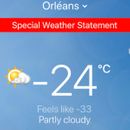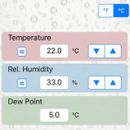Effectiveness of window shrink film demonstrated
I’m not sure if I have posted about this before, but I put window shrink film on my windows about two years ago with the intention of being able to maintain a higher indoor relative humidity without having water pooling below the windows.
Right now in Ottawa it is -24°C. Indoor conditions are 22°C and 33% relative humidity, dewpoint of 5°C. A chilly night, but pretty comfortable indoors.
As the pictures hopefully show, our builder grade circa 2004 double pane windows are holding up quite well under these conditions. The windows with bug screens have a bit more accumulation, showing some larger water droplets. But the windows without bug screens only have a minor amount of water vapour collecting at the bottom. None of the windows have enough water accumulation to cause any dripping.
I’m impressed with the effectiveness of this film, though it is a bit of a pain to get it installed without visible wrinkles. I have it installed on the glass unit surround instead of over the whole window, so the windows can still be opened and bug screens attached. This leaves about a 3/8” gap between the plastic film and the glass.
Without this film, there’s no way I could keep indoor relative humidity this high without having water pooling at the bottom of the windows and running down the walls.
GBA Detail Library
A collection of one thousand construction details organized by climate and house part












Replies
The extra pictures wouldn’t attach above for some reason.
Still can’t get the pictures...
OK, so we need to do them one at a time by the looks of things.
Try again...
OK, looks like uploading pictures from the mobile site just doesn’t work very well. You can see what I’m talking about pretty much from the one picture.
Can you upload a pic with the screen removed to better show the effects? I’ve had the same problem as you with uploading pics and only seem to be able to upload them one at a time.
With the film, you’re effectively adding an extra “pane” and associated insulating air space. A poor man’s version of a triple pane window, essentially. Perhaps a “SemiSerious” window (a humorous take on Alpen Windows parent company :-). Alpen Windows is known for using suspended films in place of extra panes of glass in their very efficient windows.
Bill
Hi Bill,
The effect with the screens left in place is more of a larger water droplet forming, vs just a light mist forming without the bug screens. Keep in mind I have a humidifier running on my furnace to keep my RH above 30%. Without a humidifier running our RH would be below 20%, I'd have nosebleeds all the time, and my wife would be terrified of touching doorknobs for fear of getting a shock!
I must add, I do have one window (with bug screen) that had water pooling at its base. This is a small window in our powder room. This room is always cold (poor HVAC design/execution likely) which means the colder air is more likely to condense on the surface of that window. I will be removing the bug screen to keep this from happening in the future.
Windows in occupied bedrooms seem to gather a bit more moisture along the bottom edge, likely due to higher humidity from having a human present.
The colder air isn't more likely to condense. It's that the surface will be colder because it's not getting warmed as much by the room air.
When you talk about the condensation collecting at the bottom, I'm assuming you mean condensation on the surface of the film running down to the window sill. How much condensation is happening between the film and the glass?
Neat little review Lance. My triple pane windows in the master bedroom are dripping (interior RH @ 38% in family room). They are european tilt and turns. The worst part is actually the inside metal hinge that has a shit load of condensation dripping. The master is the only location, on the north east corner of the house, in full wind exposure, connected to an ensuite bath with "only" ERV exhaust, and 2 adults sleeping. Humidity might be higher in the master than elsewhere.
Triple pane windows in living room, and kids bedrooms show no signs of condensation. ZERO, even at these cold temps.
My front door has 5 horizontal dual panes, and they show heavy condensation.
Stay warm!
I have -20C the last few days and 30% humidity and also builder grade windows, and lots of shocks and dry skin.
No condensation so far but i would like to get some extra humidity and have thought about window film just to see what would happen for the future
Also i have had image posting troubles in my question as well, seems to a bug somewhere.
Very easy to build your own double pane inserts using old screen frames and plastic wrap with edging foam around the perimeter. We've had them for over 10 years and what a difference it makes. You can sit/stand next to the window and always feel warm. Never condensation even after cooking and nearing 50% at -15F. Or you can buy very nice ones: http://www.energywisemfg.com/